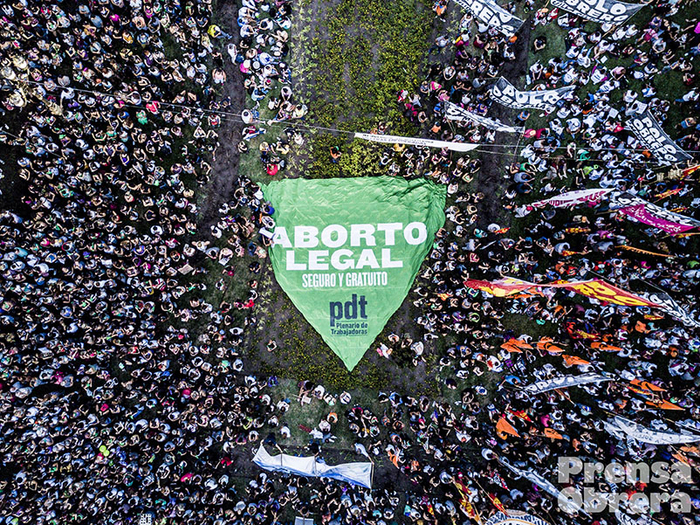For the first post in our Gender, Emotions, and the Colours of Protest Series, Vera Mackie and Sharon Crozier-De Rosa analyse the colour green at pro-choice protests.

In June 2022, protesters across the USA took to the streets to signify their support for reproductive rights. They were rallying in response to the Supreme Court decision in the case of Dobbs v. Jackson Women’s Health Organization. This decision had the effect of removing a woman’s right to seek an abortion, a right which had been affirmed in the 1973 case of Roe v. Wade.
The demonstrations in June 2022 were the culmination of two years of campaigning on reproductive rights. Even before the Supreme Court decision, several states had passed laws restricting access to abortion. The arena of struggle for reproductive rights has now shifted to individual state assemblies.
Many of the US protesters wore green scarves or bandanas. The connection between the colour green and reproductive rights began in the early 2000s in Argentina and was consolidated in the late 2010s.
The movement to decriminalise abortion in Argentina was known as the ‘Marea Verde’, or ‘Green Wave’. These activists looked back to the Madres de Plaza de Mayo (Mothers of the Plaza de Mayo) who had worn white scarves in their regular protests at those who had been ‘disappeared’ (the desaparecidos) in Argentina under the military regime. The green scarves or bandanas have assumed popular political significance in the movement for reproductive rights.
Some contend that the selection of the colour green was a pragmatic one, adopted at the 2003 iteration of the annual National Women’s Meeting in Rosario, which demanded the right to legal, safe, and free abortion. It has been claimed that an organiser could not find enough bandanas in purple, the colour of feminism, so they resorted to distributing abundantly available green scarves. Others, such as Mariana Ardila, explain that reproductive rights activists ‘selected green as the colour of health and hope’.

The use of the green scarf to signify reproductive rights spread to other countries. Professor of Sociology, Naomi Braine, explains that the green bandana emerged from ‘the longstanding, militant, and increasingly successful struggles for abortion rights in Latin America’ to become an international symbol of abortion rights.
To date, abortion has been decriminalised in Argentina and Colombia, but is still banned in the Dominican Republic, Haiti, El Salvador, Honduras and Nicaragua. Green bandanas have been defended by prominent female politicians, such as Puerto Rico Senator Maria de Lourdes Santiago, and derided by others, including Mexican senator Lilly Téllez, who called it a symbol of ‘death’.

The green scarf has also spread elsewhere. It was taken up by demonstrators in Poland, when a near-total ban on abortion was enacted in January 2021. More recently, it was seen in this year’s demonstrations for reproductive justice in the United States. New York Member of Congress Nydia Vélasquez wore a green scarf when she marched to the Senate with other Democratic members to demand senators pass legislation to put abortion rights into federal law.
The green bandana symbolises the increasingly transnational nature of abortion activism that has been facilitated by the availability and use of online technology which connects movements in countries like Ireland, Poland, Argentina, and the United States. Green, which typically evokes nature – demonstrated through political parties advocating environmentalism having ‘green’ in their titles – is currently used internationally to produce feminist solidarity over women’s rights over their own bodies.
The movement of the green scarf from South America to North America at a time when reproductive rights are under threat also signifies a form of trans-American solidarity. As it travels north, crossing multiple borders, the green scarf also represents an intervention into generally accepted understandings of the flow of feminist knowledge between north and south.

As sociologist Naomi Braine writes, the Global South has much to teach the Global North about fighting for reproductive justice. US activists, she argues, ‘can draw inspiration, lessons, and strategy from the dynamic feminist movement across Central and South America’, including focusing more on providing ‘solidarity-based feminist collectives that offer information and support on medication abortion in a variety of different legal and social contexts, [amid]…swiftly changing laws’.
Whatever its origins, green has been adopted to symbolise transnational solidarity on the issue of access to safe abortion across the globe. Its evocation of women’s right to protect their bodies connects activists from diverse regional contexts. This use of green has also been deployed for intra-feminist ends – to demonstrate the reality of the shifting geopolitics of gender, acting to remind us that ‘progress’ is a fragile and unstable thing, and that the flow of knowledge and influences is multidirectional.
 Vera Mackie is Emeritus Professor in the School of Humanities and Social Inquiry at the University of Wollongong. With Sharon Crozier-De Rosa, she is the co-author of Remembering Women’s Activism (Routledge, 2019). Vera tweets as @veramackie.
Vera Mackie is Emeritus Professor in the School of Humanities and Social Inquiry at the University of Wollongong. With Sharon Crozier-De Rosa, she is the co-author of Remembering Women’s Activism (Routledge, 2019). Vera tweets as @veramackie.
 Sharon Crozier-De Rosa is Associate Professor in the School of Humanities & Social Inquiry, University of Wollongong. With Vera Mackie, she is the co-author of Remembering Women’s Activism (Routledge, 2019). Sharon tweets as @S_CrozierDeRosa.
Sharon Crozier-De Rosa is Associate Professor in the School of Humanities & Social Inquiry, University of Wollongong. With Vera Mackie, she is the co-author of Remembering Women’s Activism (Routledge, 2019). Sharon tweets as @S_CrozierDeRosa.
Copyright remains with individual authors who grant VIDA holding a perpetual, world-wide, royalty free and non-exclusive license to use, distribute, reproduce and promote content. For permission to re-publish any VIDA blog post, in whole or in part, please contact the managing editors at auswhn@gmail.com.au
